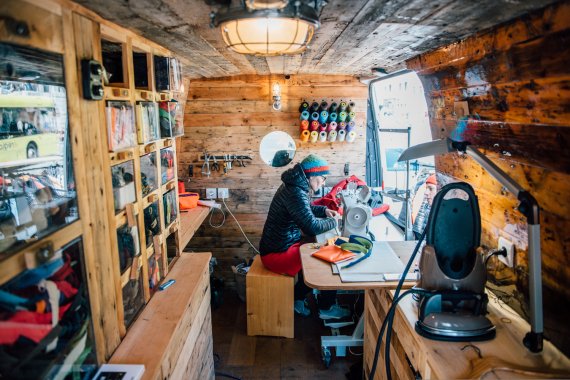
Millennials were born 1980 and 2000 – and thus are the first generation to grow up with the Internet. This explains why they differ from the older target groups. The Internet , and above all social media, have had a decisive influence on the attitudes and behavior of Millennials.
ISPO.com characterizes the target group in eleven theses and show how the sporting goods industry can coordinate their strategies accordingly. The biggest challenges lie in communication and trend affinity.
Absolutely crucial for the sporting goods industry: “Millennials have an all-inclusive perception of sports, and sports are part of their lifestyle,” says Alan Rownan, analyst at Euromonitor International. This can be seen in the way they consume sports, how they do sports, how they organize their free time, and how they eat. And: They combine sports with health and the experience.
A suitable in-store tool for this would be a café/bar area, which can also emerge from a collaboration with a startup from the health food sector. Another example would be a yoga class like that introduced at Lululemon.
The media shows a one-dimensional image of Millennials driving fitness. “The athletic behavior of Millennials isn’t defined by individual sports,” explains Rownan. 21% of athletically active Millennials worldwide are committed team sports, and 20% to individual sports. 19% of that same group regularly attend fitness classes. (Source: Euromonitor).

Millennials keep themselves informed online and exchange thoughts with people like them on social media before a purchase decision. If the industry wants to become part of this decision-making process, it has to move away from one-way communication and towards personal dialog on Instagram, Facebook, Twitter, Pinterest, etc.
Rownan says that social media should not only inspire, but also motivate. Quote: “The increased and sustained influence of training routines and diet plans by competitive athletes will further motivate Millennials.”
The global trend towards healthy snacks stems in large part from Millennials. They also have a proclivity towards vitamins and dietary supplements. 20% take them daily. (Source: Euromonitor)
Having grown up in the uniform look of fashion discounters, Millennials have developed a sense for quality and exclusivity. Nevertheless, 55% see a disparity between the price and the product quality (source: EY, 2016). If the industry wants to bear up against this critical inspection, it has to make its production processes transparent.
Millennials believe in man-made climate change. Transparency is therefore required in terms of ecological behavior, as well. A critical attitude towards consumption is typical for the “Millennial state of mind,” as the analysts at Bain & Company write. In the sense of sustainability, for instance, repair services are also relevant. One example of this is the Patagonia Worn Wear Tour.
Millennials are looking for brands “whose values and passions match their own” (Bain & Company). The mission requires storytelling. This means content on the company’s history, its production processes, collaborations, and the like. Content that can be used on all communication channels.
“Millennials prefer the experience over consumption,” says Rownan. In Western nations, they spend an average of 16% of their income on experiences, i.e. leisure, recreation, travel, and food service. In the sporting goods industry, conveying an experience is obvious, but has so far mainly been practiced by specialists. One example from the industry is the outdoor company Mammut, which provides activities in the mountains and makes the brand come alive with its ‘Alpine School.’
Millennials take no stock in conservative role models. But the majority of the sporting goods industry is persistently male-oriented, and not configured towards women in either its products or its mentality. This leads to the fashion factor being underestimated and some of the most exciting topics – such as athleisure – being left up to online fashion stores. New York-based trend researcher Haysun Hahn agrees. She’s demanding more fashion competence in the sporting goods industry.

Millennials want to follow their own personal style, independent of brands. Large runs of seasonal collections contradict this. Capsule collections offer a far higher degree of fashion and individuality. According to the fashion specialists and trend researchers at the WGSN (World Global Style Network), collaborations are becoming a key element in marketing.
Millennials are faster in their purchase decisions than older consumers. They take approximately one third less time. For successful communication, brand and retail staff have to match up to the Millennials’ degree of information.
Millennials’ consumer behavior seems to be contagious. The analysts at Bain & Company believe that this group’s behavior has also already crossed over to the older generations. Thus, the “Millennial state of mind” is formative for 73% of buyer groups.

 Sports BusinessSki Mountaineering Goes Olympic: What Milano-Cortina 2026 Means
Sports BusinessSki Mountaineering Goes Olympic: What Milano-Cortina 2026 Means
- ISPO awards
- Mountain sports
- Bike
- Design
- Retail
- Fitness
- Health
- ISPO Job Market
- ISPO Munich
- ISPO Shanghai
- Running
- Brands
- Sustainability
- Olympia
- OutDoor
- Promotion
- Sports Business
- ISPO Textrends
- Triathlon
- Water sports
- Winter sports
- eSports
- SportsTech
- OutDoor by ISPO
- Heroes
- Transformation
- Sport Fashion
- Urban Culture
- Challenges of a CEO
- Trade fairs
- Sports
- Find the Balance
- Product reviews
- Newsletter Exclusive Area
- Magazine





